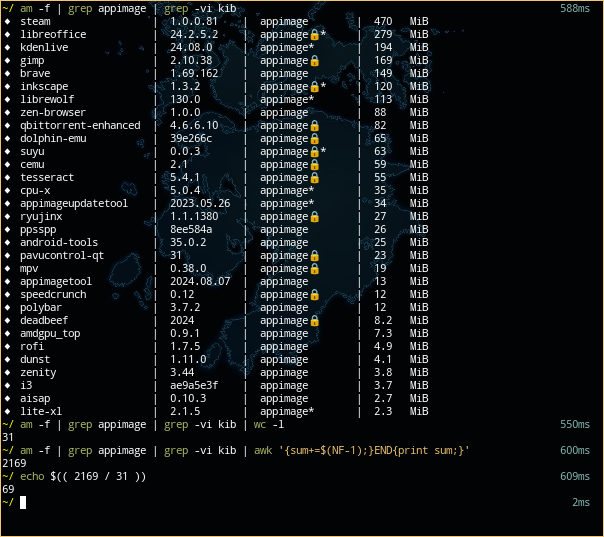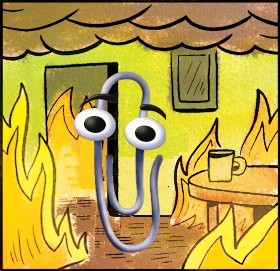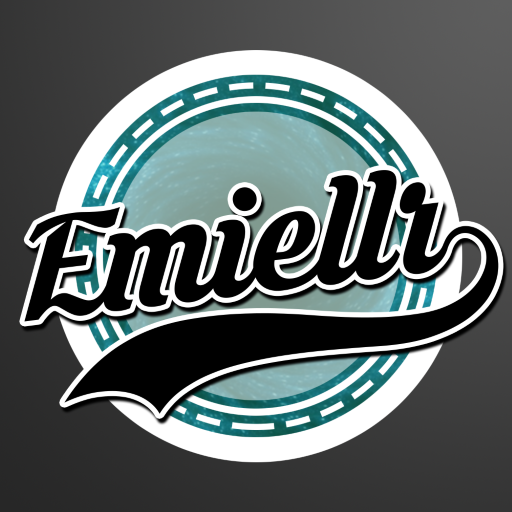How do you guys get software that is not in your distribution’s repositories?
There is no software that is not in AUR. I use arch, BTW.
But yeah, sometimes I just compile from source, if needed.
That’s exactly what the vast majority of AUR packages do already? You can also apply modifications to the compilation process if needed.
Indeed, but don’t underestimate my laziness.
My software, QuickDAV, is not in the AUR. It’s open source, and I release it only as an AppImage, because I am lazy.
I guess we should have added the word “notable”
I’m terribly sorry, you left the door wide open ;)
I’m curious, what makes AppImage a good choice for the lazy developer? Is it easier to create?
Ouch. xD
It’s super easy to create. And you distribute it on your own, so it’s basically like an installer exe on Windows. In my mind it’s one step above only offering source code.
I’m curious, what makes AppImage a good choice for the lazy developer? Is it easier to create?
The appimage is basically just
git clone->make->make install DESTDIR=/path/to/AppDir->wget appimagecreationtooland finallyappimagecreationtool /path/to/AppDirand that’s it you have your appimage.appimagecreationtool being several tools that can create the appimage from an AppDir, like linuxdeploy, linuxdeploqt, go-appimage, etc
And that on itself isn’t complex either, it if basically running ldd on the binary, then copy those libraries into the AppDir and finally run patchelf to patch the paths in the binaries and libraries, suyu uses a deploy script instead of using those tools, which I’ve recently forked and began expanding.
I don’t know how easy it is to make a flatpak or snap, but I do know the dev of zen browser hates dealing with the flatpak and iirc right now the flatpak is outdated as result.
EDIT: Also lite-xl has been making a flatpak for like 2 years and it isn’t ready yet.
There’s so much random, useful software distributed only as appimages. But not notable enough for packaging fanboys.
Rpg paper maker
Though the Linux version is now in a “do not use” state. The developer decided to just make it into a web app because it was only working on Ubuntu
i use arch based btw (I love my Manjaro and it’s AUR support) :>
Gatekeeping the word “software” here?
Here’s something not in the AUR. Tested on archClearly we need an Arch version of rule 34 and rule 35
Rule 34a: If linux software exists, it’s in the AUR. No exceptions.
Rule 35a: If linux software is not in the AUR, it will be made available in the AUR.
I don’t intend on pushing that one to the AUR. It’s not worth it.
Maybe I’ll make an AppImage at most.I don’t know any formal requirements for it being on AUR, but I just feel like this one does not fit there.
Sorry, I’ve already posted the new internet rules and they took immediate effect, I’ll have to report this incident to…the council.
Someone will put the AppImage in AUR
This is such a weird gatekeeper take
Its a joke lol, why are you so serious all the time
If you don’t compile from source, do you even Linux?
Linux From Scratch user detected
Or Slackware
Or gentoo.
Ah … yeah … totally. I would never use some filthy peasant distro like Mint. No sir! Never never ever!
Native package manager > Native binaries > AppImage > Flatpak.
Yes, snap isn’t even on the scale.
Not a fan of AppImages myself. For an universal format it has surprising amount of issues with different distros, in my experience. And the whole Windows style “go to a website, download the AppImage, if you want to update it, go to the web page again and download it again” is one thing I wanted to get away from. At least they don’t come with install wizards, that clicking through menus thing was a pain.
For one off stuff I run once and never need again, AppImage is alright. But not being built-in with sandboxing, repos, all that stuff, it just seems like a step back.
I ran into the same issues, mentally, when trying out AppImages for the first time - but my attitude changed once I found and started using this tool: https://github.com/ivan-hc/AM
Glad you like AM.
So it’s Scoop, but for Linux? (That’s a compliment. I love Scoop.)
App images are a very Windows way to do things. They bundle everything so they are big
They are windows, but the linux version of dll-hell across distros and distro versions makes windows dll hell look quaint.
If someone had addressed that better it would be one thing, but binary interoperability is infinitely broken, so app image is actually an improvement.
Isn’t the gnome runtime alone 2GiB? You know how many appimages that is?
Not to mention you are unlikely to only use one runtime.
Then again, loads of apps share that runtime. And if other runtimes have same stuff as that GNOME runtime, the shared parts are on your disk only once. It’s pretty smart in how it works.
Ran out of space on a 30GB partition when trying around 10 smallish programs as flatpaks. Runtimes are shared in theory but not in practice.
If you allocate 30 GB for / that seems pretty low these days for a desktop system. If you don’t have much space, it’s always best to go with regular repository packages
Here someone had 163 flatpaks and it used 8,7GB in runtimes. So I’m guessing the 30GB number is for whole of /.
I just checked out mine, I have 34 apps and runtimes use 3,1GB
Runtimes are shared in theory but not in practice.
I think three runtimes (newest freedesktop, KDE and GNOME) cover 90% of my flatpaks. Then there’s programs that use some EOL’d runtime and never get updated, which sucks
It was on a phone, and 25 GB was Flatpak
I tested installing some web browers, kdenlive, yuzu and libreoffice and without knowing I ended up with 3 different runtimes and the total storage usage (with deduplication) was 4.79 GIB.
Meanwhile with 33 appimages that I have (which includes same flatpak apps I mentioned) are using 2.2 GiB.
It doesn’t matter if they share if in the end they end up using several times more storage than the appimage equivalent.
You should test it out with those 33 installed as flatpak. If you end up with 4.7GB for runtimes, that’s basically nothing these days as far as storage goes for that amount of programs. More you have, more you benefit from shared runtimes. I doubt it’ll be less than AppImages but it’s usually the starting runtime space use that shocks people.
Here someone tested it with 163 flatpaks and the runtimes used 8.7GB. With the top 5 most used runtimes covering 128 of those flatpaks.
https://blogs.gnome.org/wjjt/2021/11/24/on-flatpak-disk-usage-and-deduplication/
I just checked out mine, I have 34 apps and runtimes use 3,1GB
It doesn’t matter if they share if in the end they end up using several times more storage than the appimage equivalent.
Well we are talking about two gigs, after all. Unless you’re using an embedded system, it’s not a much of a concern if you ask me. But it is more, true
. If you end up with 4.7GB for runtimes, that’s basically nothing these days
Yes but that wasn’t the original comment I replied to was about.
163 flatpaks and the runtimes used 8.7GB
163 flatpaks using 8.7 GiB means that the average flatpak is using 54.6 MiB.
That’s good the other time I got this linked: https://tesk.page/2023/06/04/response-to-developers-are-lazy-thus-flatpak/#but-flatpaks-are-easier-for-end-users
Which is no good as in that example there was 173 flatpaks using 27.66 GiB, average 160 MiB, while in your case the average flatpak is using 91 MiB.
This is what I have with appimages:

In this case the average appimage is using 69 MiB, though there is one outliner which is the Steam appimage that I have there (470 MiB) which is an entire conty container with its own video drivers and everything, without it the average would be 56 MiB.
I know this doesn’t matter these days but once again that wasn’t what the original comment was about.
Well we are talking about two gigs, after all. Unless you’re using an embedded system, it’s not a much of a concern if you ask me. But it is more, true
Thanks for the link showing an average flatpak using 54 MiB though, didn’t think it was possible lol.
WAIT I just took a deeper look at the link, isn’t that guy just showing the runtimes without the applications using 8.7 GiB?
Yes but that wasn’t the original comment I replied to was about.
I know this doesn’t matter these days but once again that wasn’t what the original comment was about.
I agree, it was just about the size differences. I just think it’s good to bring up since there’s many confused about the flatpak size use. Often people might want to install some small app and they’re hit with gigs of stuff and come off thinking that’s the same for every app, which would be insane of course.
WAIT I just took a deeper look at the link, isn’t that guy just showing the runtimes without the applications using 8.7 GiB?
Yes it’s specifically comparing runtimes. Same for my number, I was calculating how much the runtimes used.
I’m a technically savvy but new to Linux user who installed Mint as my primary OS about a month ago. So far I’ve used Flatpaks and AppImages without any issue and haven’t come across snaps. Would you explain the differences and why I would care about one over another?
At the end of the day, they’re just different ways of reaching the same goal: universal packages for Linux. I personally use them interchangeably depending on the application and use case.
There are some packages that definitely work better and are intended to be used and installed via your native package manager (if they rely on system libraries and whatnot). But using either a Flatpak or AppImage results in the same experience - in my experience. It’s a personal preference.
IMO flatpaks are the future of installing linux apps. The comment you replied to lives in the past. System package manager should be for system binaries, not for applications.
But I like my applications years out of date and I think its good that every distro has to spend manhours on packaging it individually.
lmao you joke but half this thread is exactly that opinion
I see the appeal for the package manager for a lot of things, but space got so incredibly cheap and fast that duplication is way less of a deal than the effort to make stuff work the traditional way. But im not a real linux user. I don’t like tinkering, I want to download something and it works. And the amazing thing is we can have both. If people like spending time to package something be my guest.
The funniest interaction I had recently. I downloaded a program that isn’t in my package manager or had any sort of flatpack/appimage so I downloaded it as a deb and it didn’t run because of some dependency. So I could clone the git and build it from source which might have worked, but I was too lazy to. So I just downloaded the windows exe and ran it through wine, which worked flawlessly.
you are a real linux user don’t let some neckbeard tell you otherwise :P
I don’t like tinkering, I want to download something and it works.
And this is what’s keeping Linux at bay. Normies are that to the extreme. They want something that is as simple and resilient as possible, they couldn’t care less about the dependencies or even know what they are. They want
a programan app and just install it from an “app store” if possible.
And the last three aren’t even an option in the enterprise unless your CTO is 24.
Why not just stick to what we’ve always been doing?
- wget something.tar.gz
- tar something.tar.gz
- man tar
- tar xzf something.tar.gz
- cd something
- ls -al
- ./config.sh
- chmod +x config.sh
- ./config.sh
- make config
- Try to figure out where to get some obscure dependency, with the right version number. Discover that the last depency was hosted on the dev’s website that the dev self-hosted when it went belly up 5 years ago. Finally find the lib on some weird site with a TLD you could have sworn wasn’t even in latin characters.
- make config
- make
- Go for coffee
- make install
- SU root
- make install
I much prefer our modern package format solutions:
- sudo apt install something
- open
- wtf this is like 6 months old
- find a PPA hosted by someone claiming to have packaged the new version
- search how to install PPAs
- sudo apt <I forgot>
- install app finally
- wtf it’s 2 months old and full of bugs
- repo tells me to report to original developer
- report bugs
- mfw original dev breaks my kneecaps for reporting a bug in out of date versions packed with weird dependency constraints they can’t recreate
We should normalize programs that don’t use such exotic and impossible libraries that you have to do anything besides type “make” and “make install” for it to work.
In theory it’s a no brainer. In practice not so much.
in the end we end up using containers afaict
deleted by creator
I’m currently on a atomic distro, so how I get my software from favorite to least favorite is this:
- Flatpak
- Appimage
- Fedora distrobox
- rpm-ostree
Have you met nix?
Nix is cool but also incredibly painful
I use nix package manager on fedora silverblue. It’s awesome.
Awesomely painful
Why is it painful for you?
It just is overly complex. Nix has its own environment instead of just being a regular package manager.
os-tree is slow as molasses
As it should be, don’t do that.
Doctor, when I do this it hurts…
Also, you’re creating a disk image…
It is. I also wonder if there was a model that accomplishes the same thing but with less image copying.
Like, make snapshots every day, but manual installs are not snapshotted but still tracked with ostree. So you can revert them, display them transparently etc.
finally, somebody in this thread who doesn’t live in the past.
System package manager is for system binaries. Not for applications.
Native repos > AUR > compile from source > Flatpak
Mine is
AppImage > Native repos > AUR > Manually compiling from source > Finding an alternative
I don’t like installing software that doesn’t need to be installed, thus I like AppImage. Pretty portable. That also applies to compiling from source. Yes, my home directory is a mess.
cant we just have .deb?
On arch?
If you look at some aur packages, it’s probably deb…
we got tar.zst
And windows has .zip? That’s not the same…
i mean arch linux deb version is tar.zst no joke
I was going be a smart ass and make the “I use Arch joke”… But if you can use .debs on Arch, that’s kind of neat.
The issue is with pushing updates. Eget is nice, but it doesn’t push updates.
Appimages are crap too, but at least there is progress with AppMan, repos and that sandboxing solution.
Snaps are only sandboxed with Apparmor and snapd only allows a single repo (which contained malware multiple times) so get the hell off my lawn XD
Just use flatpak. It runs and installs local but still has the benefits of a package manager
Yup.
I hate fucking snap. It might be enough to make me switch distros if Ubuntu keeps up with it (which I am sure they intend to).
The continual “you have new snaps” or whatever it was message every time I’m just trying to have a web browser open made me eventually figure out how to install firefox for real on all of my computers.
EDIT: I think you may have convinced me to try out Debian on my next OS installation.
The Firefox snap was the reason I left Ubuntu. (Or, the last straw, at least.) Fedora has been wonderful.
Try debian, they improved so much over the past decade, they’re a better Ubuntu than Ubuntu now without any bullshit.
What do you mean “improved”? Ubuntu is based on Debian.
It used to be really outdated and missing new applications, with a kernel 1 major version behind.
All that is fixed, they even have good support for new architectures like riscv on par with Ubuntu.
Make a script to extract it to /opt/local and make a symlink.
You’ll end up using it so much and it’s an easier upgrade on your terms.
curl
|sudo bash
very smart much secure
But it gets the job done, chaotic good
I don’t remember what program it was, the dev explained it wasn’t available as flatpak because flatpaks are unsafe or something. Then the installation guide went “well anyway here’s curl | sudo bash.” Like, lmao. Talk about bad security practices.
Download the sources and build it, like Kernighan & Richie intended.
sounds like a modern approach
AUR. If it doesn’t exist on AUR (very unlikely, but happens sometimes), I make a package for it.
On non-arch distros, I often use LURE.
How safe is LURE?
I only use my own installer scripts with LURE, so I’m not sure about the safety of the publicly available repos. But the project itself seems to be pretty solid and reliable.
Linux noob here, can someone ELI5 why snaps are bad? And how does .deb works?
Snaps are a standard for apps that Ubuntu’s parent company, Canonical, has been trying to push for years.
The issue that most people have with them, is that Canonical controls the servers, which are closed source. Meaning that only they can distribute Snap software, which many Linux users feel violates the spirit & intention of the wider free and open source community.
Appimages and Flatpaks are fully open source standards, anybody can package their software in those ways and distribute them however they want.
.deb files are software packaged for the Debian distribution, and frequently also work with other distros that are based on Debian, like Linux Mint.
Some further context on this that @Dop@lemmy.world might want to know:
While Canonical’s snap store is proprietary (which, to be clear, I don’t really like), all the client software is open source and the API is well documented (though a bit janky). Their snap store relay app (which is open source) has a full implementation of it. There was a fully functional open snap store for a while, but the project died out of a lack of interest. You can also distribute snaps through another mechanism and install them locally on the machine (though you then lose the benefit of snapd’s auto updates). You can even do this with snapd still checking the signatures of the snaps.
The standard for snaps is fully open, as is snapd itself.
There’s no need to oversell the negatives to the point of being wrong.
Interesting, didn’t know it was feasible to make the distribution open.
That doesn’t give me much to complain about in theory, but canonical has lost way too much good faith to give people a reason to keep open snap distribution going for free. They should definitely consider hosting an open store just to get people on board again.
It was being done by a group of snapd developers at Canonical, IIRC, but after a couple of years of exactly zero interaction from anyone outside Canonical I think they just gave up and decided it wasn’t worth it because they were getting accused of trying to monopolise whether they had an open store or just an open API.
Of course, you can also distribute snaps without using the snap store API. I’ve used this for airgapped machines in the past. You can either just grab the
.snapfile (which is just a squashfs file with ameta/snap.yamlin it so snapd knows how to treat it) and install it with--dangerous, or you can include an assertion file for that snap signed by a certificate that your machine’s snapd trusts and not even have to do that. (Those airgapped machines trusted our own certificate so we could ensure that the snaps came from our CI process and weren’t a developer’s random test snap).
Thanks, I recently needed picocrypt and not being comfortable with the terminal, snap were a rather convenient way to get it installed, I’ll avoid them from now on.
The primary thing I hate about them is that every snap package appears to your system as a separate mounted filesystem. So if you look in your file explorer, you can potentially see dozens of phantom drives clogging up your sidebar.
I don’t think snaps are bad (and when someone tries to explain why they are, about 85% of the time they say something wrong enough that I suspect they’re probably just parroting someone else rather than actually knowing what’s going on). It’s sad, because if we could get rid of the bullshit we could actually have decent discussions about the benefits and shortcomings of snaps (and how to fix those shortcomings).
On the .deb front: it’s a package format made by Debian. Each archive contains a data tarball, which has the files in the package in their full structure from
/, and a control tarball, which contains metadata such as name, version and dependencies as well as pre-install, pre-remove, post-install and post-remove scripts, which are used doing any setup or removal work that can’t be done just by extracting or deleting the files.The upside of deb files is that they tend to be pretty small. The downside is that this typically comes from having a tight coupling to library versions on the system, which means upgrading a library can break seemingly unrelated things. (This is why you get warnings like this page: https://wiki.debian.org/DontBreakDebian) Many third party distributors (e.g. Google with Chrome) take care of this by packaging most dependencies inside the deb, inflating the size.
Another major difference between packages like debs and rpms and newer formats like snaps and flatpaks is that the latter have confinement systems to prevent apps from having full access to your system.
For me, it was
snapdtaking ~2.5GiB of RAM.Worth noting that the confinement of Flatpaks and Snaps can have major drawbacks. It has been a major pain in the ass to get Flatpaks working nicely with fractional scaling (think tiny cursor, huge text, tiny text etc etc)
Nothing in theory makes that an issue of flatpaks and snap, just that both rely on different means to interact with the host system that have been woefully slow to implement. If enough protocols are developed a flatpak or snap should be as capable as a native app with the safety benefits for free.
If you look through the desktop portals GitHub, it seems to be a mess of bikeshedding, mostly on the part of a small number of people on the flatpak side. Canonical seem to have been working around this in snaps by writing their own interfaces as stopgaps until the desktop portals catch up, probably because they got such pushback when the similar frustration on the display server side resulted in them releasing mir with its own protocol until the Wayland folks could get their act together.
While you’re right in pointing out that in theory it’s basically as capable as native, it’s a royal pain in the ass as it is right now, which disqualifies it from a great deal of applications.
Honestly if not for the convoluted Linux FS layout, debs would be pretty serviceable and aren’t really different to the Windows solution. The fs layout makes installations way too fickle to clashing with other applications.
That and dependency hell, which distros should have never been allowed to touch beyond the core dependencies required to get your desktop running.
Well that’s what
/optis for. Well-behaved application packages that aren’t part of your core distro should install themselves in there.
Nothing necessarily at the tech level. They’re more capable than Appimages or flatpaks to the point that you can use it to build a reproducible system hardened against tampering or defective updates.
The downside is that it’s controlled entirely by canonical, has limited abilities (if any?) for hosting storefronts/packages outside of their ecosystem, and said ecosystem is insecure and has already allowed multiple waves of malicious apps to reach end users because of poor moderation of listings masquerading as legitimate versions.
Canonical has also been increasingly hostile to flatpaks - removing it from Ubuntu and derivatives by default to push users towards snap.
The whole loopfs thing is just an annoyance, but the aggressive posturing by canonical as well as the closed nature of the storefront that has led to malicious attacks on end users is enough to give it more than a few haters.
The snap store is some proprietary store Canonical runs, and snaps are friggin huge in size. I don’t really know though as I don’t use Ubuntu anymore
The first two snaps I compared sizes of on my system are uv and bitwarden. The uv snap is 9.5 megs vs. the wheel’s 12.2 megs, and the bitwarden snap is 97 megs vs. the Deb’s 79 megs and the AppImage’s 114 megs. These seem pretty reasonable - doubly so since snaps also have delta updates.
OK that’s better than what I’ve seen. Notepadqq I think was 2.4gb and I said no to that one. But again I don’t run Ubuntu.
I don’t use Notepadqq anywhere (I use kate btw), but on my KDE Neon system it’s currently showing:
$ snap info notepadqq name: notepadqq summary: A Notepad++-like editor for Linux. publisher: Daniele Di Sarli (danieleds) store-url: https://snapcraft.io/notepadqq license: GPL-3.0 description: | It helps developers by providing all you can expect from a general purpose text editor, such as syntax highlighting for more than 100 different languages, code folding, color schemes, file monitoring, multiple selection and much more. You can search text using the power of regular expressions. You can organize documents side by side. You can use real-time highlighting to find near identifiers in no time. snap-id: 6iueWFAtx9P2OQz4SIW64Kry9hT8aUCL channels: latest/stable: 1.4.8 2018-09-14 (855) 151MB - latest/candidate: ↑ latest/beta: 2.0.0-beta+git 2019-10-12 (890) 201MB classic latest/edge: 2.0.0-beta+git 2019-10-16 (897) 197MB classicIt seems to be a dead project (the last release on GitHub is that same 2.0 beta from 2019), but looking at the snapcraft.yaml file, it looks like it’s because they’re vendoring in a pretty big chunk of KDE and gtk libraries. 2019 was before I started doing anything with snaps or flatpaks for desktops so I’m not sure what the state of KDE content snaps was then (I know there was a GNOME one because the core18 gnome content snap is installed on my system for uhh… some app that I have), but these days for desktop apps there are content snaps for gnome (published by Canonical) and KDE Frameworks (published by KDE) to deduplicate those dependencies.
Size isn’t an issue imo. Applications are bulky for many more reasons than their packaging formats.
AUR or flatpak.
Honestly the longer I spend daily driving Linux the more I enjoy using flatpaks…
I try my hand at packaging it for my distro.
the hero we need






















